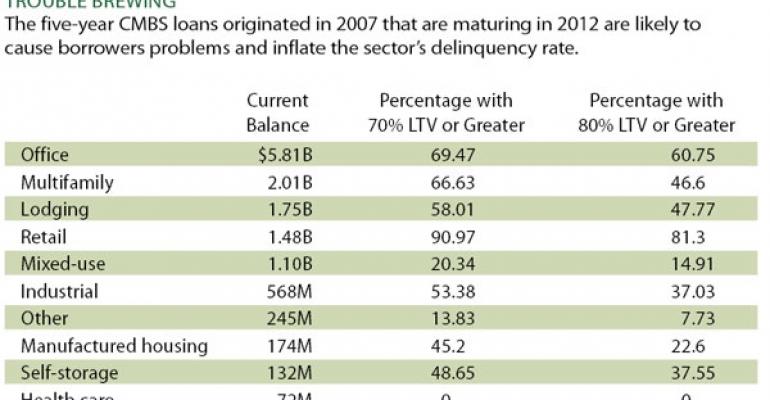For much of the past few years, the CMBS delinquency rate has climbed to vertiginous heights, breaking all futility records in the process.
After bottoming at 0.28 percent in June 2007, according to Morningstar, the CMBS delinquency rate began to rise soon after commercial real estate values and vacancy rates fell. The rate peaked at 8.43 percent in July 2011 and as of the end of November had retreated mildly to 8.19 percent. Loans originated with aggressive underwriting assumptions about future occupancies, rents and values turned sour quickly. And even though quite a few troubled loans were “extended and pretended,” that practice didn’t prevent many loans from going bad.
In 2011, things stabilized a bit. While the delinquency rate continued to climb, it was not in the large monthly jumps that marked previous years. And some of the troubled loans were even being resolved.
But 2012 begins a dangerous new stage for the CMBS sector. That’s because some of the most aggressive loans written in 2007 are now coming due. Five-year debt originated at the peak of the market is hitting its maturity, and there are real questions as to whether much of it can be paid down or refinanced.
According to Standard & Poor’s, these loans are a cause for concern because a large number include high loan-to-value ratios, limited amortization and borrower equity buildup and reduced liquidity in the market. Moreover, roughly one-third of these loans are in the office sector, where, coincidentally, five-year lease terms are common. As those leases come due, office owners may face challenges retaining the tenants or signing new long-term leases.
Overall, $55 billion worth of commercial mortgage-backed securities is scheduled to mature this year—the most for any year to date. Of that $19 billion are five-year loans initiated in 2007 and it’s top heavy, with 85 percent of those loans coming due during the first six months of the year. That’s out of a total of roughly $580 billion in commercial debt that will mature this year, according to Willy Walker, chairman, president and CEO of Bethesda, Md.-based Walker & Dunlop, a commercial real estate finance company.
“You’ve got a big overhang of CMBS loans that are either not being refinanced or being extended in 2009, 2010 and 2011,” Walker says. “I don’t think there will be enough capital for all the deals that want to get financed.”

And experts are not predicting a happy outcome. For example, Standard & Poor’s estimates that between 50 percent and 60 percent of the five-year term loans may fail to refinance. Trepp LLC, which estimated that the CMBS delinquency rate stood at 9.58 percent at the end of 2011, projects that the rate could rise by a further 75 basis points in the next six to 12 months, largely as a result of the 2007 five-year loans reaching their balloon dates.
To put that in context, Trepp pointed out that in 2011, $13.7 billion in 2006-vintage five-year balloon loans reached their maturity date. Of that amount, $9.9 billion remains with almost 60 percent of that volume in special servicing and 45.9 percent are currently delinquent. In addition, another 8 percent are past their balloon date, but only making current interest payments while 22 percent have stopped making interest payments altogether.
As of late November, 27 percent of 2007 five-year loans are in special servicing and 18.5 percent are currently 30 or more days delinquent. Trepp expects those numbers to increase dramatically as 2012 plays out.

As it stands, 2007 vintage loans have been a problem. Already, 579 loans with a total balance of $5.33 billion have experienced some losses, according to Trepp. Overall, there have been $2.71 billion in realized losses, a loss severity rate of 50.73 percent. The year accounts for more than one-quarter of the cumulative $10.68 billion in losses for fixed-rate conduit loans.
The other big question facing the CMBS sector is on the originations side. Last year was a rocky one marked by fits and starts. But ultimately the volume still was the highest since the onset of the crisis. Through three quarters, CMBS issuance amounted to $35.24 billion. In fact, CMBS issuance in 2011 was more than in the previous three years combined, even if it was nearly $200 billion short of the peak volume of $230.17 billion posted in 2007.
The question remains, however, as to what 2012 will bring.
Since peaking at $822.3 billion in the fourth quarter of 2007, the volume of outstanding commercial mortgage-backed securities has fallen for 15 straight quarters and stood at $650.34 billion at the end of the third quarter of 2011, according to Wells Fargo Securities LLC and Intex Solutions Inc.
“If CMBS did an incredible amount of originations in 2012, they might do $50 billion,” Walker predicts—about a quarter of the volume completed during the industry’s peak year. “There is still a large gap that needs to be filled by somebody and I don’t know who that somebody is. We’ll still have a pretty big gap.”

